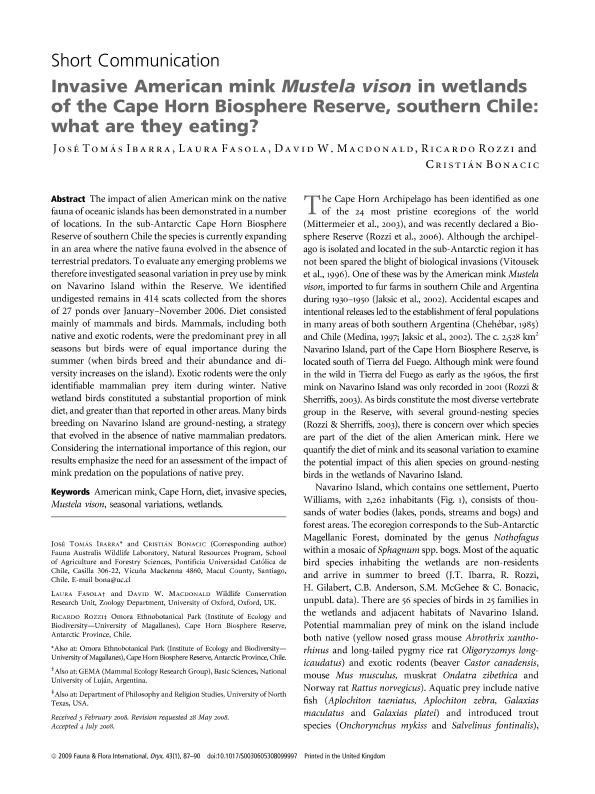Mostrar el registro sencillo del ítem
dc.contributor.author
Ibarra, Jose Tomas
dc.contributor.author
Fasola, Laura

dc.contributor.author
Macdonald, David W.
dc.contributor.author
Ricardo, Rozzi
dc.contributor.author
Cristián, Bonacic
dc.date.available
2021-05-07T11:06:56Z
dc.date.issued
2009-01
dc.identifier.citation
Ibarra, Jose Tomas; Fasola, Laura; Macdonald, David W.; Ricardo, Rozzi; Cristián, Bonacic; Invasive american mink mustela vison in wetlands of the cape horn biosphere reserve, southern Chile: What are they eating?; Cambridge University Press; Oryx; 43; 1; 1-2009; 87-90
dc.identifier.issn
0030-6053
dc.identifier.uri
http://hdl.handle.net/11336/131628
dc.description.abstract
The impact of alien American mink on the native fauna of oceanic islands has been demonstrated in a number of locations. In the sub-Antarctic Cape Horn Biosphere Reserve of southern Chile the species is currently expanding in an area where the native fauna evolved in the absence of terrestrial predators. To evaluate any emerging problems we therefore investigated seasonal variation in prey use by mink on Navarino Island within the Reserve. We identified undigested remains in 414 scats collected from the shores of 27 ponds over JanuaryNovember 2006. Diet consisted mainly of mammals and birds. Mammals, including both native and exotic rodents, were the predominant prey in all seasons but birds were of equal importance during the summer (when birds breed and their abundance and diversity increases on the island). Exotic rodents were the only identifiable mammalian prey item during winter. Native wetland birds constituted a substantial proportion of mink diet, and greater than that reported in other areas. Many birds breeding on Navarino Island are ground-nesting, a strategy that evolved in the absence of native mammalian predators. Considering the international importance of this region, our results emphasize the need for an assessment of the impact of mink predation on the populations of native prey.
dc.format
application/pdf
dc.language.iso
eng
dc.publisher
Cambridge University Press

dc.rights
info:eu-repo/semantics/openAccess
dc.rights.uri
https://creativecommons.org/licenses/by-nc-sa/2.5/ar/
dc.subject
AMERICAN MINK
dc.subject
CAPE HORN
dc.subject
DIET
dc.subject
INVASIVE SPECIES
dc.subject
MUSTELA VISON
dc.subject
SEASONAL VARIATIONS
dc.subject
WETLANDS
dc.subject.classification
Ecología

dc.subject.classification
Ciencias Biológicas

dc.subject.classification
CIENCIAS NATURALES Y EXACTAS

dc.title
Invasive american mink mustela vison in wetlands of the cape horn biosphere reserve, southern Chile: What are they eating?
dc.type
info:eu-repo/semantics/article
dc.type
info:ar-repo/semantics/artículo
dc.type
info:eu-repo/semantics/publishedVersion
dc.date.updated
2021-01-18T14:18:05Z
dc.journal.volume
43
dc.journal.number
1
dc.journal.pagination
87-90
dc.journal.pais
Reino Unido

dc.journal.ciudad
Cambridge
dc.description.fil
Fil: Ibarra, Jose Tomas. Pontificia Universidad Católica de Chile; Chile
dc.description.fil
Fil: Fasola, Laura. Consejo Nacional de Investigaciones Científicas y Técnicas. Centro Austral de Investigaciones Científicas; Argentina. University of Oxford; Reino Unido
dc.description.fil
Fil: Macdonald, David W.. University of Oxford; Reino Unido
dc.description.fil
Fil: Ricardo, Rozzi. Universidad de Magallanes; Chile
dc.description.fil
Fil: Cristián, Bonacic. Pontificia Universidad Católica de Chile; Chile
dc.journal.title
Oryx

dc.relation.alternativeid
info:eu-repo/semantics/altIdentifier/url/https://www.cambridge.org/core/journals/oryx/article/invasive-american-mink-mustela-vison-in-wetlands-of-the-cape-horn-biosphere-reserve-southern-chile-what-are-they-eating/5C42689D418D4FE1588CDE99EAB04D95
dc.relation.alternativeid
info:eu-repo/semantics/altIdentifier/doi/https://doi.org/10.1017/S0030605308099997
Archivos asociados
